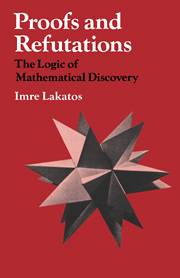
Proofs and Refutations
Encyclopedia

Imre Lakatos
Imre Lakatos was a Hungarian philosopher of mathematics and science, known for his thesis of the fallibility of mathematics and its 'methodology of proofs and refutations' in its pre-axiomatic stages of development, and also for introducing the concept of the 'research programme' in his...
expounding his view of
the progress of mathematics
Mathematics
Mathematics is the study of quantity, space, structure, and change. Mathematicians seek out patterns and formulate new conjectures. Mathematicians resolve the truth or falsity of conjectures by mathematical proofs, which are arguments sufficient to convince other mathematicians of their validity...
. The book is written as a series of Socratic dialogue
Socratic dialogue
Socratic dialogue is a genre of prose literary works developed in Greece at the turn of the fourth century BC, preserved today in the dialogues of Plato and the Socratic works of Xenophon - either dramatic or narrative - in which characters discuss moral and philosophical problems, illustrating a...
s involving a group of students who debate the proof of the Euler characteristic
Euler characteristic
In mathematics, and more specifically in algebraic topology and polyhedral combinatorics, the Euler characteristic is a topological invariant, a number that describes a topological space's shape or structure regardless of the way it is bent...
defined for the polyhedron
Polyhedron
In elementary geometry a polyhedron is a geometric solid in three dimensions with flat faces and straight edges...
. A central theme is that definition
Definition
A definition is a passage that explains the meaning of a term , or a type of thing. The term to be defined is the definiendum. A term may have many different senses or meanings...
s are not carved in stone, but often have to be patched up in the light of later insights, in particular failed proof
Mathematical proof
In mathematics, a proof is a convincing demonstration that some mathematical statement is necessarily true. Proofs are obtained from deductive reasoning, rather than from inductive or empirical arguments. That is, a proof must demonstrate that a statement is true in all cases, without a single...
s. This gives mathematics a somewhat experimental flavour. At the end of the Introduction, Lakatos explains that his purpose is to challenge formalism in mathematics
Formalism (mathematics)
In foundations of mathematics, philosophy of mathematics, and philosophy of logic, formalism is a theory that holds that statements of mathematics and logic can be thought of as statements about the consequences of certain string manipulation rules....
, and to show that informal mathematics grows by a logic of "proofs and refutations".
The pupils in the book are named after letters of the Greek alphabet.
Many important logical ideas are explained in the book. For example the difference between a counterexample
Counterexample
In logic, and especially in its applications to mathematics and philosophy, a counterexample is an exception to a proposed general rule. For example, consider the proposition "all students are lazy"....
to a lemma
Lemma (mathematics)
In mathematics, a lemma is a proven proposition which is used as a stepping stone to a larger result rather than as a statement in-and-of itself...
(a so-called 'local counterexample') and a counterexample to the specific conjecture under attack (a 'global counterexample' to the Euler characteristic, in this case) are discussed.
Lakatos argues for a different kind of textbooks, one that uses heuristic style. To the critics that say they would be too long, he replies: 'The answer to this pedestrian argument is: let us try.'
The 1976 book has been translated into more than 15 languages worldwide, including Chinese, Korean and Serbo-Croat, and went into its second Chinese edition in 2007.
The Method of Proofs and Refutations
Though the book is written as a narrative, an actual method of investigation, that of "proofs and refutations", is developed. In Appendix I, Lakatos summarizes this method by the following list of stages:- Primitive conjecture.
- Proof (a rough thought-experiment or argument, decomposing the primitive conjecture into subconjectures).
- "Global" counterexamples (counterexamples to the primitive conjecture) emerge.
- Proof re-examined: the "guilty lemma" to which the global counter-example is a "local" counterexample is spotted. This guilty lemma may have previously remained "hidden" or may have been misidentified. Now it is made explicit, and built into the primitive conjecture as a condition. The theorem - the improved conjecture - supersedes the primitive conjecture with the new proof-generated concept as its paramount new feature.
He goes on and gives further stages that might sometimes take place:
- Proofs of other theorems are examined to see if the newly found lemma or the new proof-generated concept occurs in them: this concept may be found lying at cross-roads of different proofs, and thus emerge as of basic importance.
- The hitherto accepted consequences of the original and now refuted conjecture are checked.
- Counterexamples are turned into new examples - new fields of inquiry open up.

